人教版(2019)必修第一册Welcome Unit 单元教学设计(表格式)
文档属性
| 名称 | 人教版(2019)必修第一册Welcome Unit 单元教学设计(表格式) | 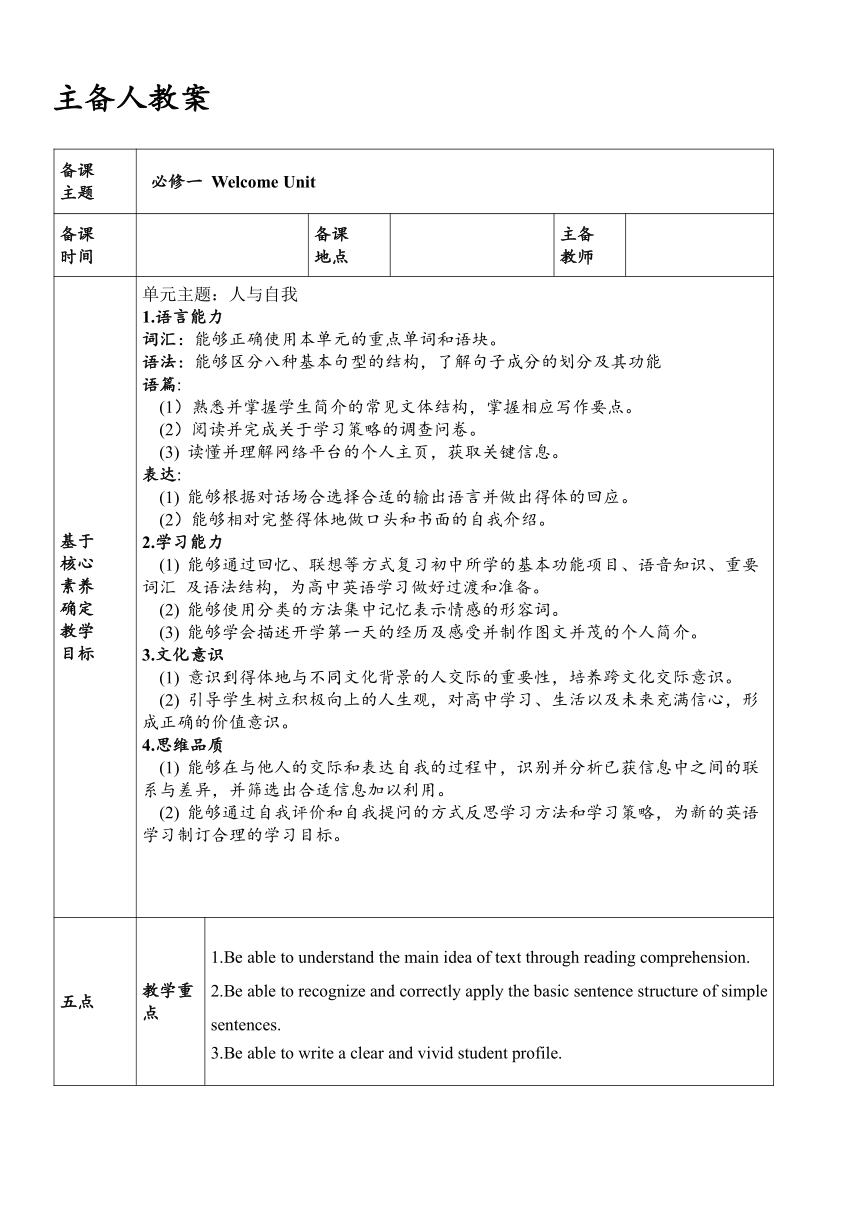 | |
| 格式 | docx | ||
| 文件大小 | 163.9KB | ||
| 资源类型 | 教案 | ||
| 版本资源 | 人教版(2019) | ||
| 科目 | 英语 | ||
| 更新时间 | 2024-10-31 17:32:19 | ||
图片预览

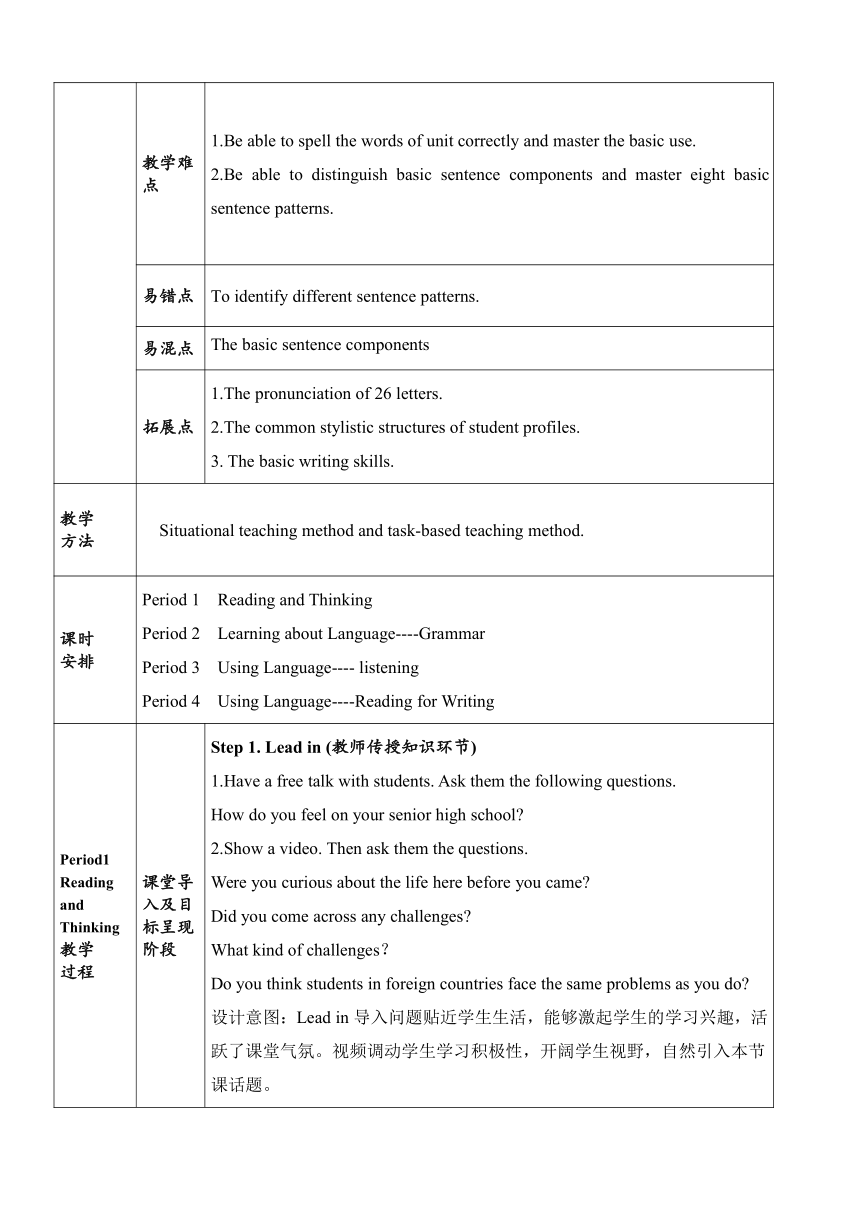
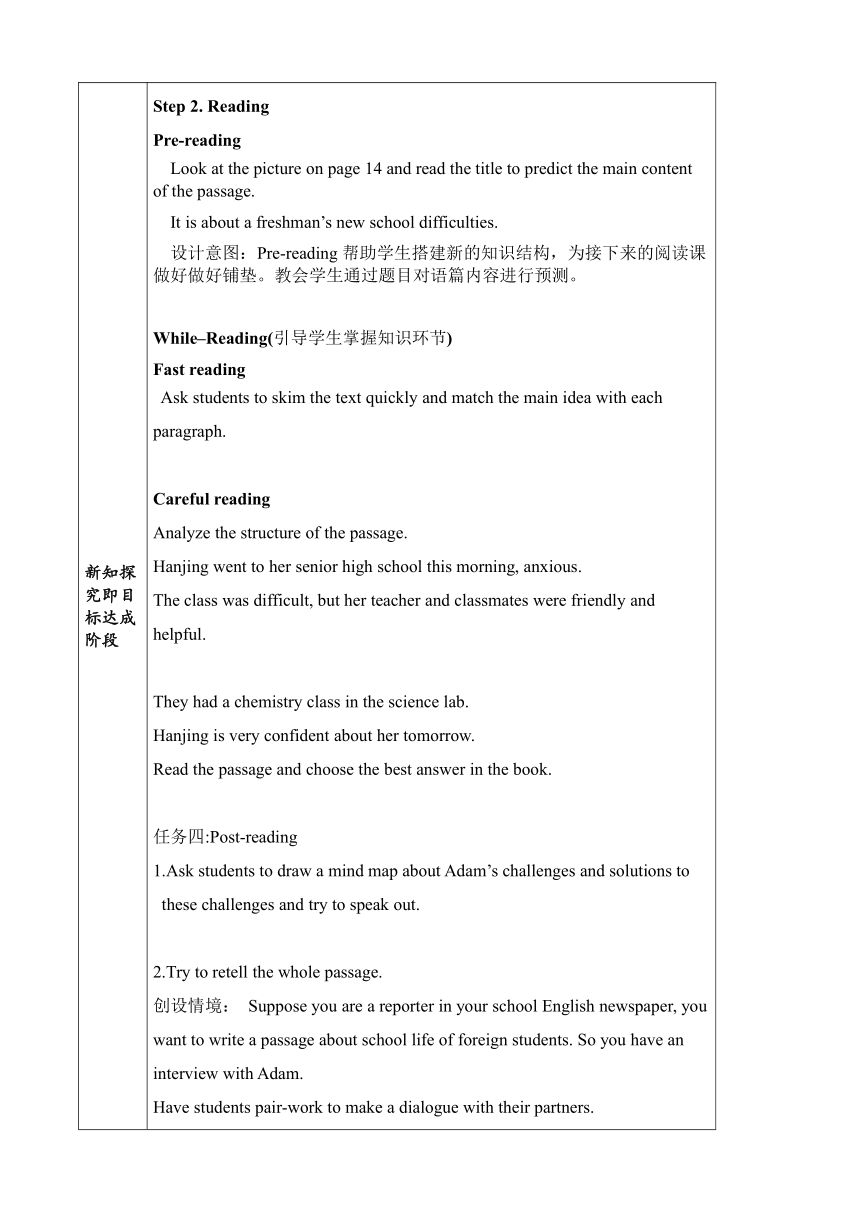
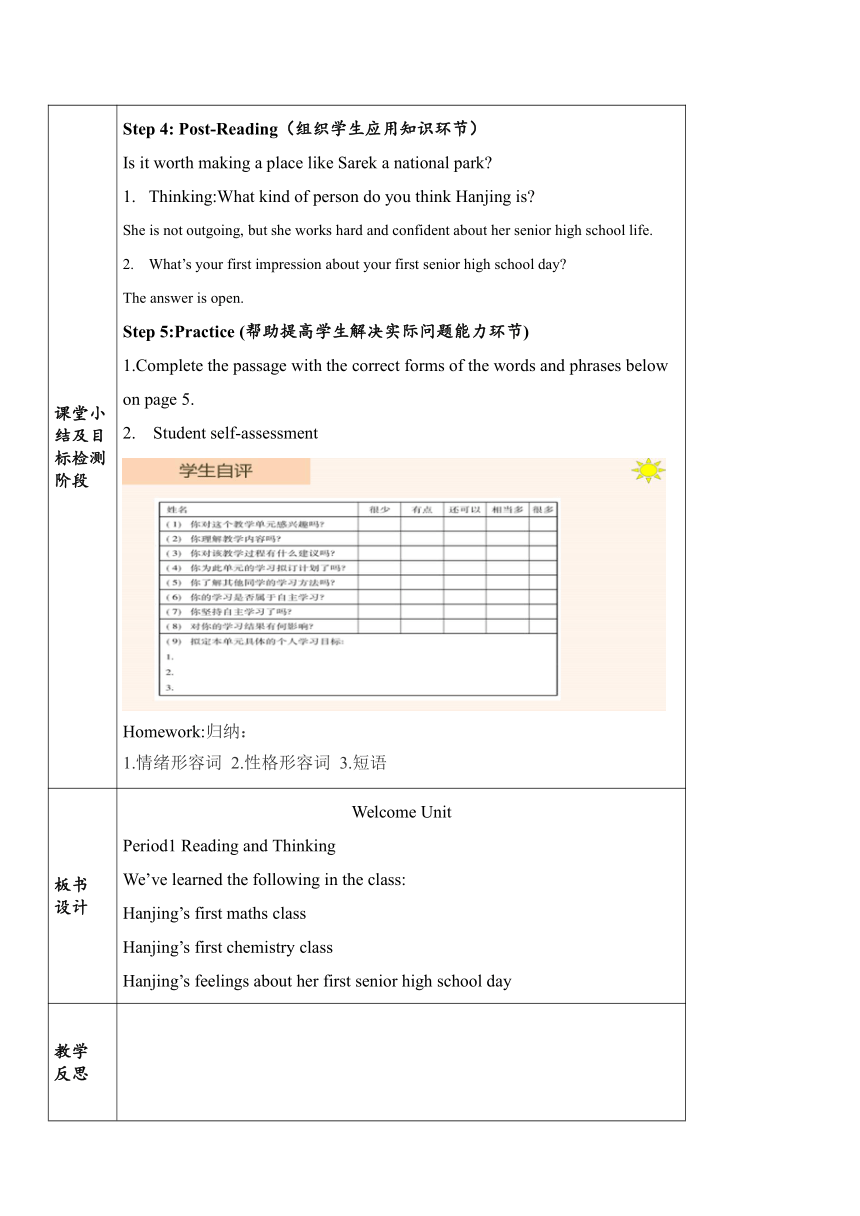
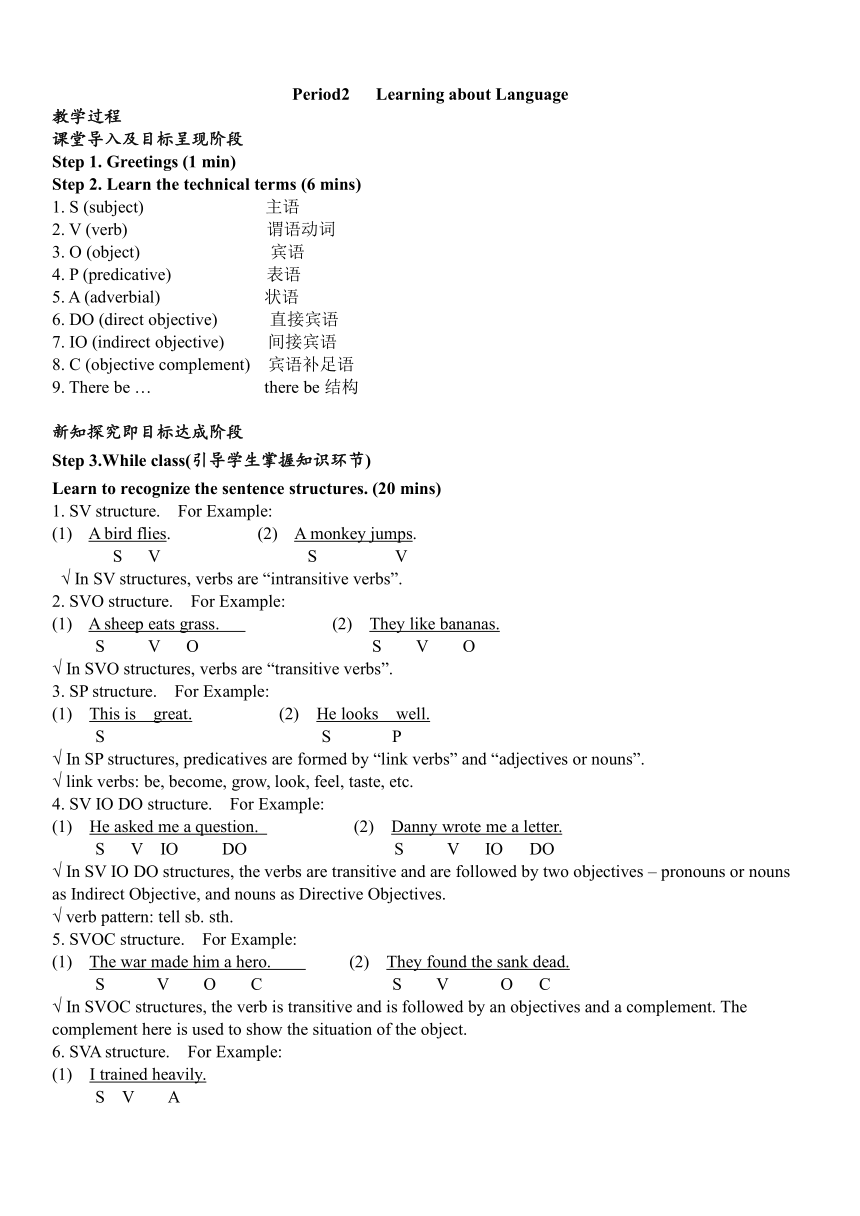
文档简介
主备人教案
备课 主题 必修一 Welcome Unit
备课 时间 备课 地点 主备 教师
基于 核心 素养 确定 教学 目标 单元主题:人与自我 1.语言能力 词汇:能够正确使用本单元的重点单词和语块。 语法:能够区分八种基本句型的结构,了解句子成分的划分及其功能 语篇: (1)熟悉并掌握学生简介的常见文体结构,掌握相应写作要点。 (2)阅读并完成关于学习策略的调查问卷。 (3) 读懂并理解网络平台的个人主页,获取关键信息。 表达: (1) 能够根据对话场合选择合适的输出语言并做出得体的回应。 (2)能够相对完整得体地做口头和书面的自我介绍。 2.学习能力 (1) 能够通过回忆、联想等方式复习初中所学的基本功能项目、语音知识、重要词汇 及语法结构,为高中英语学习做好过渡和准备。 (2) 能够使用分类的方法集中记忆表示情感的形容词。 (3) 能够学会描述开学第一天的经历及感受并制作图文并茂的个人简介。 3.文化意识 (1) 意识到得体地与不同文化背景的人交际的重要性,培养跨文化交际意识。 (2) 引导学生树立积极向上的人生观,对高中学习、生活以及未来充满信心,形成正确的价值意识。 4.思维品质 (1) 能够在与他人的交际和表达自我的过程中,识别并分析已获信息中之间的联系与差异,并筛选出合适信息加以利用。 (2) 能够通过自我评价和自我提问的方式反思学习方法和学习策略,为新的英语学习制订合理的学习目标。
五点 教学重点 1.Be able to understand the main idea of text through reading comprehension. 2.Be able to recognize and correctly apply the basic sentence structure of simple sentences. 3.Be able to write a clear and vivid student profile.
教学难点 1.Be able to spell the words of unit correctly and master the basic use. 2.Be able to distinguish basic sentence components and master eight basic sentence patterns.
易错点 To identify different sentence patterns.
易混点 The basic sentence components
拓展点 1.The pronunciation of 26 letters. 2.The common stylistic structures of student profiles. 3. The basic writing skills.
教学 方法 Situational teaching method and task-based teaching method.
课时 安排 Period 1 Reading and Thinking Period 2 Learning about Language----Grammar Period 3 Using Language---- listening Period 4 Using Language----Reading for Writing
Period1 Reading and Thinking 教学 过程 课堂导入及目标呈现阶段 Step 1. Lead in (教师传授知识环节) Have a free talk with students. Ask them the following questions. How do you feel on your senior high school Show a video. Then ask them the questions. Were you curious about the life here before you came Did you come across any challenges What kind of challenges? Do you think students in foreign countries face the same problems as you do 设计意图:Lead in导入问题贴近学生生活,能够激起学生的学习兴趣,活跃了课堂气氛。视频调动学生学习积极性,开阔学生视野,自然引入本节课话题。
新知探究即目标达成阶段 Step 2. Reading Pre-reading Look at the picture on page 14 and read the title to predict the main content of the passage. It is about a freshman’s new school difficulties. 设计意图:Pre-reading帮助学生搭建新的知识结构,为接下来的阅读课做好做好铺垫。教会学生通过题目对语篇内容进行预测。 While–Reading(引导学生掌握知识环节) Fast reading Ask students to skim the text quickly and match the main idea with each paragraph. Careful reading Analyze the structure of the passage. Hanjing went to her senior high school this morning, anxious. The class was difficult, but her teacher and classmates were friendly and helpful. They had a chemistry class in the science lab. Hanjing is very confident about her tomorrow. Read the passage and choose the best answer in the book. 任务四:Post-reading Ask students to draw a mind map about Adam’s challenges and solutions to these challenges and try to speak out. Try to retell the whole passage. 创设情境: Suppose you are a reporter in your school English newspaper, you want to write a passage about school life of foreign students. So you have an interview with Adam. Have students pair-work to make a dialogue with their partners.
课堂小结及目标检测阶段 Step 4: Post-Reading(组织学生应用知识环节) Is it worth making a place like Sarek a national park Thinking:What kind of person do you think Hanjing is She is not outgoing, but she works hard and confident about her senior high school life. What’s your first impression about your first senior high school day The answer is open. Step 5:Practice (帮助提高学生解决实际问题能力环节) 1.Complete the passage with the correct forms of the words and phrases below on page 5. 2. Student self-assessment Homework:归纳: 1.情绪形容词 2.性格形容词 3.短语
板书 设计 Welcome Unit Period1 Reading and Thinking We’ve learned the following in the class: Hanjing’s first maths class Hanjing’s first chemistry class Hanjing’s feelings about her first senior high school day
教学 反思
Period2 Learning about Language
教学过程
课堂导入及目标呈现阶段
Step 1. Greetings (1 min)
Step 2. Learn the technical terms (6 mins)
1. S (subject) 主语
2. V (verb) 谓语动词
3. O (object) 宾语
4. P (predicative) 表语
5. A (adverbial) 状语
6. DO (direct objective) 直接宾语
7. IO (indirect objective) 间接宾语
8. C (objective complement) 宾语补足语
9. There be … there be结构
新知探究即目标达成阶段
Step 3.While class(引导学生掌握知识环节)
Learn to recognize the sentence structures. (20 mins)
1. SV structure. For Example:
(1) A bird flies. (2) A monkey jumps.
S V S V
√ In SV structures, verbs are “intransitive verbs”.
2. SVO structure. For Example:
(1) A sheep eats grass. (2) They like bananas.
S V O S V O
√ In SVO structures, verbs are “transitive verbs”.
3. SP structure. For Example:
(1) This is great. (2) He looks well.
S S P
√ In SP structures, predicatives are formed by “link verbs” and “adjectives or nouns”.
√ link verbs: be, become, grow, look, feel, taste, etc.
4. SV IO DO structure. For Example:
(1) He asked me a question. (2) Danny wrote me a letter.
S V IO DO S V IO DO
√ In SV IO DO structures, the verbs are transitive and are followed by two objectives – pronouns or nouns as Indirect Objective, and nouns as Directive Objectives.
√ verb pattern: tell sb. sth.
5. SVOC structure. For Example:
(1) The war made him a hero. (2) They found the sank dead.
S V O C S V O C
√ In SVOC structures, the verb is transitive and is followed by an objectives and a complement. The complement here is used to show the situation of the object.
6. SVA structure. For Example:
(1) I trained heavily.
S V A
(2) He coughed badly.
S V A
√ In SVA structures, the verb is intransitive and is followed by an adverbial.
7. SVOA structure. For Example:
(1) A sheep eats grass over there.
S V O A
(2) Mum makes lunch in the kitchen.
S V O A
√ SVOA structure is formed by SVO structure plus an adverbial at the end.
8. There be structure. For Example:
(1) There is an apple on the table.
V S A
(2) There are 7 days in a week.
V S A
√ In “There be…” structure, subject and verb “be” is inverted.
√ The number of “Be” is decided by the very first subject followed.
课堂小结及目标检测阶段
Step 4: Read the passage and analyse the structures of the underlined sentences. (10 mins)
1. That dream has come true!
S P
2. Tim and his classmates are living on a ship.
S V A
3. They also learn about ships and the sea.
S V O
4. Tim writes his parents every week and tells them what happened on the ship.
S V O A V IO DO
5. There’s always something exciting to do.
V S
6. Studying and doing homework seem much more fun.
S P
Step5. Summary (帮助提高学生解决实际问题能力环节)Summary (5 mins)
In this period, we’ve learned about some important concepts of syntax.
1. The definitions of “S (subject), V (verb), O (object), P (predicative), A (adverbial), DO (direct object), IO (Indirect object) and C (object complement)”;(adverbial), DO (direct object), IO (Indirect object) and C (object complement)”;
Step 6. Homework (3 mins)
1. Recite the meanings of the capitalized initials “S (subject), V (verb), O (object), P (predicative), A (adverbial), DO (direct object), IO (Indirect object) and C (object complement)”.
2. Finish Ex. 2 and Ex. 3 on page 5.
板书设计
教学反思
Period3 Listening
教学过程
课堂导入及目标呈现阶段
Step1. Lead-in(教师传授知识环节)
Warm-up:
Free talk:
Ss talk about:
1. Do you learn English after class
2. How do you learn English in your daily life
Suggested answers:
Of course, I learn English after class. I usually listen to my English teacher and take notes and review every day.
Step2. Reflect
T shows Ss some learning strategies, and ask Ss whether they use these or not.
Then, introduce these learning strategies one by one. Firstly, introduce the features of each learning strategy, and ask Ss to think about the pros and cons.
For example, in the working in group section, T firstly introduces the picture, and asks the main features and forms of working in groups. Then, T asks Ss whether they like working in groups or not. After the discussion, T present the table to show the pros and cons of this learning strategy.
新知探究即目标达成阶段
Step3. Listening
While-listening
Ss listen to conversation 1 and tick what Li Ming likes to do.
Key words:
Flash;flash cards; flash light; a flash of lightning.
Listen and answer:
Ss listen again and answer the questions:
1. Why does Amy like group work
2. How does Li Ming organize his thoughts
3. Does Li Ming like to keep a learning diary Why or why
Suggested answers:
1. She is an outgoing person, so she likes to discuss things. Talking to others helps her remember things.
2. By making mind maps.
3. Yes, she does. Because it helps him plan his learning and what he needs to review for exams.
Brainstorming:
T asks Ss to think more learning strategies.
Suggested answers:
On my first school day, it was hard for me to say goodbye to my dear parents. It’s my first time to leave home and parents. I felt nervous and panic about my new school and new life ahead.
Finish the questionnaire:
Rate the learning methods below.
Add more of your own to the questionnaire.
T can use previous answers as examples.
Deliver a speech:
Ss are asked to Deliver a short speech about your special learning strategy.
T can provide three aspects for Ss to think:
Where did you learn it
How do you use it
What’s special about it
Think and talk:
T says there are four main aspects in English learning, reading, speaking, listening and writing. And asks Ss how to improve English from these four aspects.
Suggested answers:
1. How to improve reading
Read English picture book.
Master some reading strategy, such as scanning.
2.How to improve speaking
Talk with foreign friends. Do more imitations.
3. How to improve listening
Watch more English videos. Listen to English songs.
How to improve writing Keep diary in English.
课堂小结及目标检测阶段
Step 4. Summary
Share and discuss:
Ss are asked to Work in pairs. Share your ideas with your partner and discuss the questions.
Step 5. Practice
Homework:
Ss are asked to Watch a video and retell the strategies to improve vocabulary.
This video is about strategies to improve vocabulary, T can use it as material for leading in, or homework.
Review: 复习今日所学,查漏补缺
板书设计
Welcome Unit
Listening
Pre- listening
while-listening
After-listening
教学反思
Period 4 Reading for Writing
教学过程
课堂导入及目标呈现阶段
Step 1. Lead in(教师传授知识环节)
Step 2. Warming-up
1. What is “a student profile”
a student profile provides information about a student, and the information can be presented and used in different ways.
As a new student, what do you want to learn from other people's profiles
When you are making your profile, what would you like to show others
Let’s look at the following two examples.
设计意图:通过讨论student profile的词义,引出读写版块的主题。着重提到高中新生身份,容易引起学生共鸣,有助于对接下来的写作内容产生兴趣。
新知探究即目标达成阶段
Step 3. Writing
Fast Reading
1. Work on Activity 1. Read the student profiles and discuss the questions.
1. What is Ann like How do you know
2. What is Ann’s learning style
3. What does “You’ll never see me without a book or a pen” mean
4. What is Thando’s personality and learning style
5. Which profile do you like better Why
2. Work on Activity 2. Study the organisation and language features. A student profile includes…
3. Work on Activity 2. 1 Fill in each part with the information from the student profiles.
4. Work on Activity 2. 2 Circle the phrases that Ann and Thando use to describe their personalities and underline the sentences that they use to describe their learning styles.
5. What’s your personality and learning style
Suggested answers:
设计意图:通过阅读和分析两篇学生简介范例,使学生了解和掌握写作的内容结构和语言特点。在反复讨论两篇范文是如何描述人物性格特点和学习风格之后,请学生说说自己的情况,从而拓展更多与学生简介相关的单词、词块和句子等语言知识技能。
Step 4. While-writing
1. Work on Activity 3. Use what you have learnt to write your own student profile. 1 Complete the outline and use it to draft your student profile.
Apart from the information above, what else would you like to introduce in your profile Can you think of more expressions to introduce your personalities, hobbies and other features
2. Work on Activity 3. 2 exchange drafts. Use the checklist to give feedback on your partner’s draft.
3. Writing guidance
课堂小结及目标检测阶段
Step 5. Post-writing
Task 1. Work on Activity 4
Collect all the student profiles and create a class book.
The class book can be a book or posters…
It can also be a web page or any other electronic form.
Task 2 Building up your vocabulary
1. Work on Activity 1. Match the pictures with the best adjectives.
Work in pairs. Describe each picture in two or three sentences.
2. Work on Activity 2. Match the verbs on the left with nouns on the right.
Make sentences with the new phrases.
3. Work on Activity 3. Read the learning tips. Rewrite the underlined parts with new words from this unit that have the similar meaning.
Make your student profile into a poster or web page with appropriate pictures. As a new senior high school student, please make good use of this opportunity to introduce yourself to your classmates.
Homework
修改初稿,完善作文并上交。
板书设计
Period4 Reading for Writing
Write a student profile
1.useful words and structures
2.writing tips
教学反思
备课 主题 必修一 Welcome Unit
备课 时间 备课 地点 主备 教师
基于 核心 素养 确定 教学 目标 单元主题:人与自我 1.语言能力 词汇:能够正确使用本单元的重点单词和语块。 语法:能够区分八种基本句型的结构,了解句子成分的划分及其功能 语篇: (1)熟悉并掌握学生简介的常见文体结构,掌握相应写作要点。 (2)阅读并完成关于学习策略的调查问卷。 (3) 读懂并理解网络平台的个人主页,获取关键信息。 表达: (1) 能够根据对话场合选择合适的输出语言并做出得体的回应。 (2)能够相对完整得体地做口头和书面的自我介绍。 2.学习能力 (1) 能够通过回忆、联想等方式复习初中所学的基本功能项目、语音知识、重要词汇 及语法结构,为高中英语学习做好过渡和准备。 (2) 能够使用分类的方法集中记忆表示情感的形容词。 (3) 能够学会描述开学第一天的经历及感受并制作图文并茂的个人简介。 3.文化意识 (1) 意识到得体地与不同文化背景的人交际的重要性,培养跨文化交际意识。 (2) 引导学生树立积极向上的人生观,对高中学习、生活以及未来充满信心,形成正确的价值意识。 4.思维品质 (1) 能够在与他人的交际和表达自我的过程中,识别并分析已获信息中之间的联系与差异,并筛选出合适信息加以利用。 (2) 能够通过自我评价和自我提问的方式反思学习方法和学习策略,为新的英语学习制订合理的学习目标。
五点 教学重点 1.Be able to understand the main idea of text through reading comprehension. 2.Be able to recognize and correctly apply the basic sentence structure of simple sentences. 3.Be able to write a clear and vivid student profile.
教学难点 1.Be able to spell the words of unit correctly and master the basic use. 2.Be able to distinguish basic sentence components and master eight basic sentence patterns.
易错点 To identify different sentence patterns.
易混点 The basic sentence components
拓展点 1.The pronunciation of 26 letters. 2.The common stylistic structures of student profiles. 3. The basic writing skills.
教学 方法 Situational teaching method and task-based teaching method.
课时 安排 Period 1 Reading and Thinking Period 2 Learning about Language----Grammar Period 3 Using Language---- listening Period 4 Using Language----Reading for Writing
Period1 Reading and Thinking 教学 过程 课堂导入及目标呈现阶段 Step 1. Lead in (教师传授知识环节) Have a free talk with students. Ask them the following questions. How do you feel on your senior high school Show a video. Then ask them the questions. Were you curious about the life here before you came Did you come across any challenges What kind of challenges? Do you think students in foreign countries face the same problems as you do 设计意图:Lead in导入问题贴近学生生活,能够激起学生的学习兴趣,活跃了课堂气氛。视频调动学生学习积极性,开阔学生视野,自然引入本节课话题。
新知探究即目标达成阶段 Step 2. Reading Pre-reading Look at the picture on page 14 and read the title to predict the main content of the passage. It is about a freshman’s new school difficulties. 设计意图:Pre-reading帮助学生搭建新的知识结构,为接下来的阅读课做好做好铺垫。教会学生通过题目对语篇内容进行预测。 While–Reading(引导学生掌握知识环节) Fast reading Ask students to skim the text quickly and match the main idea with each paragraph. Careful reading Analyze the structure of the passage. Hanjing went to her senior high school this morning, anxious. The class was difficult, but her teacher and classmates were friendly and helpful. They had a chemistry class in the science lab. Hanjing is very confident about her tomorrow. Read the passage and choose the best answer in the book. 任务四:Post-reading Ask students to draw a mind map about Adam’s challenges and solutions to these challenges and try to speak out. Try to retell the whole passage. 创设情境: Suppose you are a reporter in your school English newspaper, you want to write a passage about school life of foreign students. So you have an interview with Adam. Have students pair-work to make a dialogue with their partners.
课堂小结及目标检测阶段 Step 4: Post-Reading(组织学生应用知识环节) Is it worth making a place like Sarek a national park Thinking:What kind of person do you think Hanjing is She is not outgoing, but she works hard and confident about her senior high school life. What’s your first impression about your first senior high school day The answer is open. Step 5:Practice (帮助提高学生解决实际问题能力环节) 1.Complete the passage with the correct forms of the words and phrases below on page 5. 2. Student self-assessment Homework:归纳: 1.情绪形容词 2.性格形容词 3.短语
板书 设计 Welcome Unit Period1 Reading and Thinking We’ve learned the following in the class: Hanjing’s first maths class Hanjing’s first chemistry class Hanjing’s feelings about her first senior high school day
教学 反思
Period2 Learning about Language
教学过程
课堂导入及目标呈现阶段
Step 1. Greetings (1 min)
Step 2. Learn the technical terms (6 mins)
1. S (subject) 主语
2. V (verb) 谓语动词
3. O (object) 宾语
4. P (predicative) 表语
5. A (adverbial) 状语
6. DO (direct objective) 直接宾语
7. IO (indirect objective) 间接宾语
8. C (objective complement) 宾语补足语
9. There be … there be结构
新知探究即目标达成阶段
Step 3.While class(引导学生掌握知识环节)
Learn to recognize the sentence structures. (20 mins)
1. SV structure. For Example:
(1) A bird flies. (2) A monkey jumps.
S V S V
√ In SV structures, verbs are “intransitive verbs”.
2. SVO structure. For Example:
(1) A sheep eats grass. (2) They like bananas.
S V O S V O
√ In SVO structures, verbs are “transitive verbs”.
3. SP structure. For Example:
(1) This is great. (2) He looks well.
S S P
√ In SP structures, predicatives are formed by “link verbs” and “adjectives or nouns”.
√ link verbs: be, become, grow, look, feel, taste, etc.
4. SV IO DO structure. For Example:
(1) He asked me a question. (2) Danny wrote me a letter.
S V IO DO S V IO DO
√ In SV IO DO structures, the verbs are transitive and are followed by two objectives – pronouns or nouns as Indirect Objective, and nouns as Directive Objectives.
√ verb pattern: tell sb. sth.
5. SVOC structure. For Example:
(1) The war made him a hero. (2) They found the sank dead.
S V O C S V O C
√ In SVOC structures, the verb is transitive and is followed by an objectives and a complement. The complement here is used to show the situation of the object.
6. SVA structure. For Example:
(1) I trained heavily.
S V A
(2) He coughed badly.
S V A
√ In SVA structures, the verb is intransitive and is followed by an adverbial.
7. SVOA structure. For Example:
(1) A sheep eats grass over there.
S V O A
(2) Mum makes lunch in the kitchen.
S V O A
√ SVOA structure is formed by SVO structure plus an adverbial at the end.
8. There be structure. For Example:
(1) There is an apple on the table.
V S A
(2) There are 7 days in a week.
V S A
√ In “There be…” structure, subject and verb “be” is inverted.
√ The number of “Be” is decided by the very first subject followed.
课堂小结及目标检测阶段
Step 4: Read the passage and analyse the structures of the underlined sentences. (10 mins)
1. That dream has come true!
S P
2. Tim and his classmates are living on a ship.
S V A
3. They also learn about ships and the sea.
S V O
4. Tim writes his parents every week and tells them what happened on the ship.
S V O A V IO DO
5. There’s always something exciting to do.
V S
6. Studying and doing homework seem much more fun.
S P
Step5. Summary (帮助提高学生解决实际问题能力环节)Summary (5 mins)
In this period, we’ve learned about some important concepts of syntax.
1. The definitions of “S (subject), V (verb), O (object), P (predicative), A (adverbial), DO (direct object), IO (Indirect object) and C (object complement)”;(adverbial), DO (direct object), IO (Indirect object) and C (object complement)”;
Step 6. Homework (3 mins)
1. Recite the meanings of the capitalized initials “S (subject), V (verb), O (object), P (predicative), A (adverbial), DO (direct object), IO (Indirect object) and C (object complement)”.
2. Finish Ex. 2 and Ex. 3 on page 5.
板书设计
教学反思
Period3 Listening
教学过程
课堂导入及目标呈现阶段
Step1. Lead-in(教师传授知识环节)
Warm-up:
Free talk:
Ss talk about:
1. Do you learn English after class
2. How do you learn English in your daily life
Suggested answers:
Of course, I learn English after class. I usually listen to my English teacher and take notes and review every day.
Step2. Reflect
T shows Ss some learning strategies, and ask Ss whether they use these or not.
Then, introduce these learning strategies one by one. Firstly, introduce the features of each learning strategy, and ask Ss to think about the pros and cons.
For example, in the working in group section, T firstly introduces the picture, and asks the main features and forms of working in groups. Then, T asks Ss whether they like working in groups or not. After the discussion, T present the table to show the pros and cons of this learning strategy.
新知探究即目标达成阶段
Step3. Listening
While-listening
Ss listen to conversation 1 and tick what Li Ming likes to do.
Key words:
Flash;flash cards; flash light; a flash of lightning.
Listen and answer:
Ss listen again and answer the questions:
1. Why does Amy like group work
2. How does Li Ming organize his thoughts
3. Does Li Ming like to keep a learning diary Why or why
Suggested answers:
1. She is an outgoing person, so she likes to discuss things. Talking to others helps her remember things.
2. By making mind maps.
3. Yes, she does. Because it helps him plan his learning and what he needs to review for exams.
Brainstorming:
T asks Ss to think more learning strategies.
Suggested answers:
On my first school day, it was hard for me to say goodbye to my dear parents. It’s my first time to leave home and parents. I felt nervous and panic about my new school and new life ahead.
Finish the questionnaire:
Rate the learning methods below.
Add more of your own to the questionnaire.
T can use previous answers as examples.
Deliver a speech:
Ss are asked to Deliver a short speech about your special learning strategy.
T can provide three aspects for Ss to think:
Where did you learn it
How do you use it
What’s special about it
Think and talk:
T says there are four main aspects in English learning, reading, speaking, listening and writing. And asks Ss how to improve English from these four aspects.
Suggested answers:
1. How to improve reading
Read English picture book.
Master some reading strategy, such as scanning.
2.How to improve speaking
Talk with foreign friends. Do more imitations.
3. How to improve listening
Watch more English videos. Listen to English songs.
How to improve writing Keep diary in English.
课堂小结及目标检测阶段
Step 4. Summary
Share and discuss:
Ss are asked to Work in pairs. Share your ideas with your partner and discuss the questions.
Step 5. Practice
Homework:
Ss are asked to Watch a video and retell the strategies to improve vocabulary.
This video is about strategies to improve vocabulary, T can use it as material for leading in, or homework.
Review: 复习今日所学,查漏补缺
板书设计
Welcome Unit
Listening
Pre- listening
while-listening
After-listening
教学反思
Period 4 Reading for Writing
教学过程
课堂导入及目标呈现阶段
Step 1. Lead in(教师传授知识环节)
Step 2. Warming-up
1. What is “a student profile”
a student profile provides information about a student, and the information can be presented and used in different ways.
As a new student, what do you want to learn from other people's profiles
When you are making your profile, what would you like to show others
Let’s look at the following two examples.
设计意图:通过讨论student profile的词义,引出读写版块的主题。着重提到高中新生身份,容易引起学生共鸣,有助于对接下来的写作内容产生兴趣。
新知探究即目标达成阶段
Step 3. Writing
Fast Reading
1. Work on Activity 1. Read the student profiles and discuss the questions.
1. What is Ann like How do you know
2. What is Ann’s learning style
3. What does “You’ll never see me without a book or a pen” mean
4. What is Thando’s personality and learning style
5. Which profile do you like better Why
2. Work on Activity 2. Study the organisation and language features. A student profile includes…
3. Work on Activity 2. 1 Fill in each part with the information from the student profiles.
4. Work on Activity 2. 2 Circle the phrases that Ann and Thando use to describe their personalities and underline the sentences that they use to describe their learning styles.
5. What’s your personality and learning style
Suggested answers:
设计意图:通过阅读和分析两篇学生简介范例,使学生了解和掌握写作的内容结构和语言特点。在反复讨论两篇范文是如何描述人物性格特点和学习风格之后,请学生说说自己的情况,从而拓展更多与学生简介相关的单词、词块和句子等语言知识技能。
Step 4. While-writing
1. Work on Activity 3. Use what you have learnt to write your own student profile. 1 Complete the outline and use it to draft your student profile.
Apart from the information above, what else would you like to introduce in your profile Can you think of more expressions to introduce your personalities, hobbies and other features
2. Work on Activity 3. 2 exchange drafts. Use the checklist to give feedback on your partner’s draft.
3. Writing guidance
课堂小结及目标检测阶段
Step 5. Post-writing
Task 1. Work on Activity 4
Collect all the student profiles and create a class book.
The class book can be a book or posters…
It can also be a web page or any other electronic form.
Task 2 Building up your vocabulary
1. Work on Activity 1. Match the pictures with the best adjectives.
Work in pairs. Describe each picture in two or three sentences.
2. Work on Activity 2. Match the verbs on the left with nouns on the right.
Make sentences with the new phrases.
3. Work on Activity 3. Read the learning tips. Rewrite the underlined parts with new words from this unit that have the similar meaning.
Make your student profile into a poster or web page with appropriate pictures. As a new senior high school student, please make good use of this opportunity to introduce yourself to your classmates.
Homework
修改初稿,完善作文并上交。
板书设计
Period4 Reading for Writing
Write a student profile
1.useful words and structures
2.writing tips
教学反思
